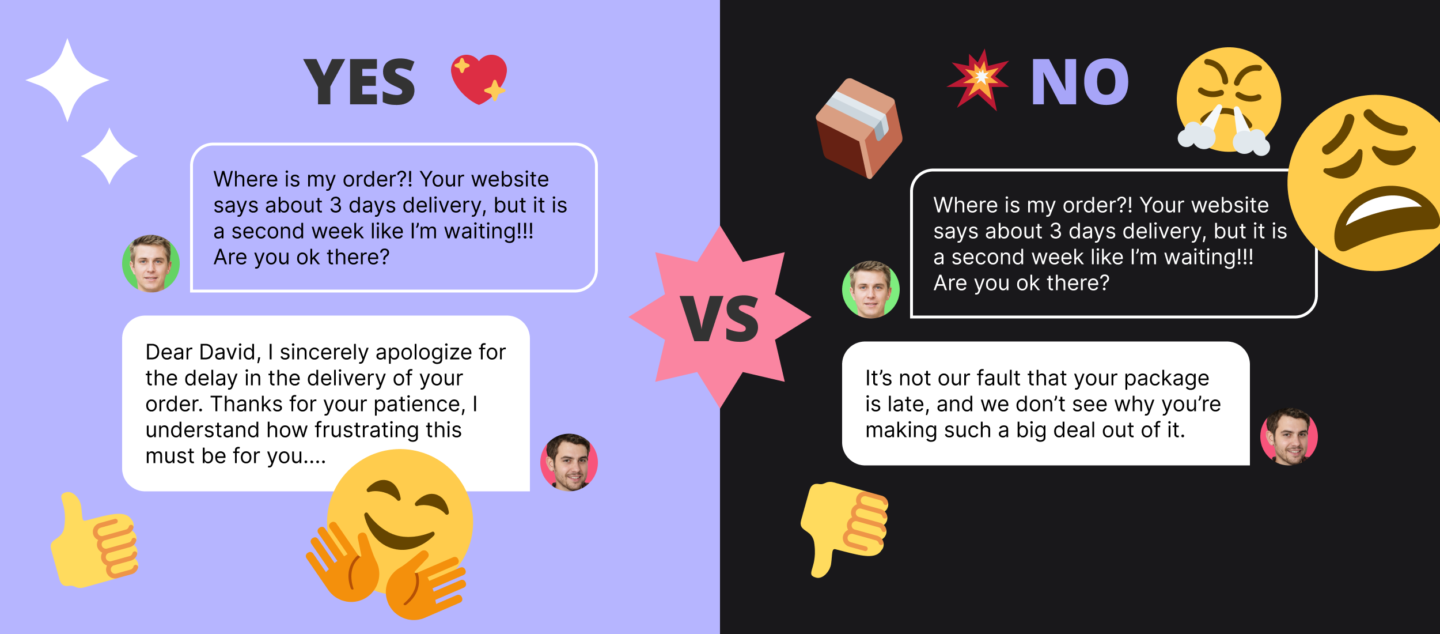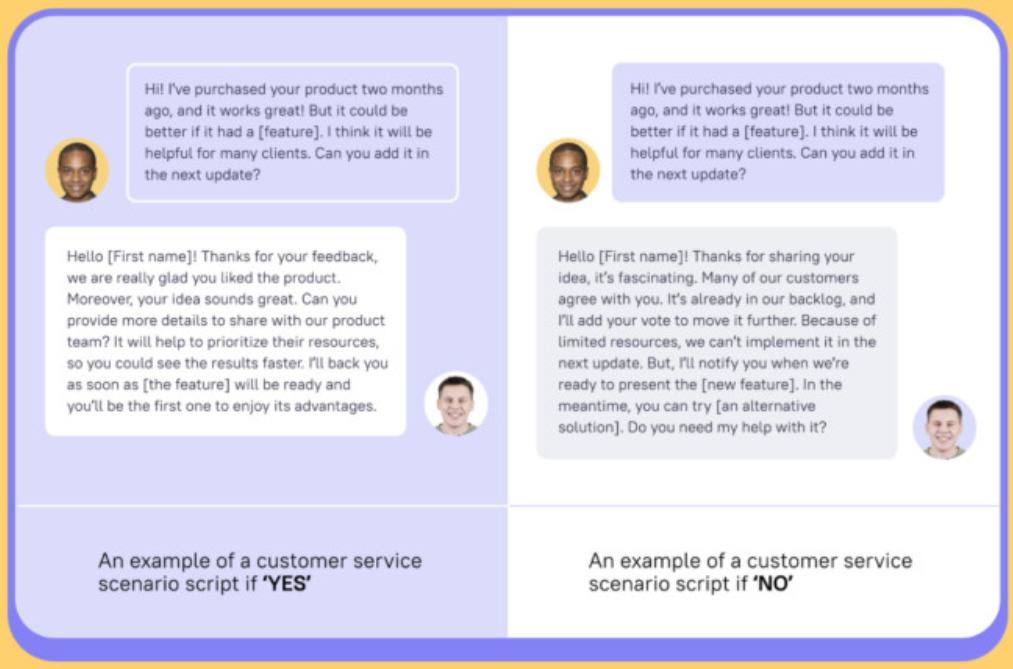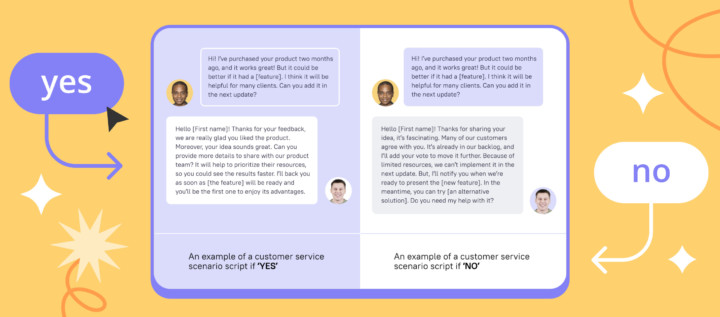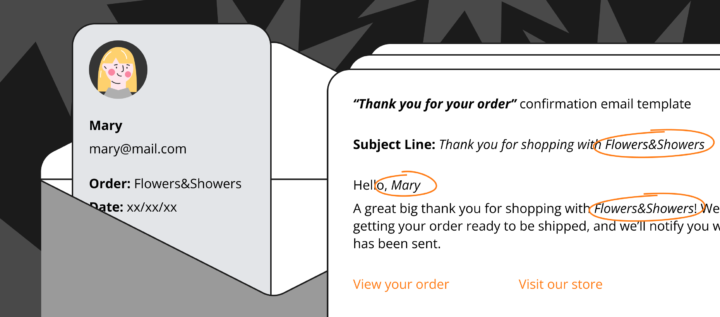Example of an impatient customer scenario and script to answer it

Picture this: In the fast-paced world of online shopping, timely delivery plays a crucial role in customer satisfaction. However, there may be instances where a product reaches the customer later than expected, resulting in frustration and dissatisfaction.
As a customer service representative, it is essential to handle these situations professionally and empathetically, regardless of the reasons behind the delay.
So how would you respond to this message 👇
Where is my order? Your website says about 3 days delivery, but it is a second week like I’m waiting!!! Are you ok there? I have plans for this purchase, you ruin my vacation! I wanna a refund now!
Bad customer support response
We have received your complaint about the delayed delivery, but you need to understand that we have many orders to process, and sometimes delays can happen. It’s not our fault that your package is late, and we don’t see why you’re making such a big deal out of it.
Demanding a refund is unreasonable, considering we’re doing our best here. You should have been more patient and waited a few days before reaching out.
The response provided is considered bad due to several reasons:
- Lack of empathy. The response fails to acknowledge the customer’s feelings or concerns and does not express understanding of their frustration.
- Defensiveness. The reply adopts a defensive tone, placing the blame on the customer and emphasizing that it’s not the company’s fault instead of focusing on finding a solution to the problem.
- Disrespectful language. The response uses phrases like “making a big deal out of it” and “you should have been more patient,” which can be dismissive and disrespectful, further aggravating the customer’s frustration.
- Absence of an apology. There is no apology or expression of regret for the inconvenience caused by the late delivery, which is essential in maintaining a positive relationship with the customer.
- No solution is offered. The response does not explain how the issue will be resolved or offer compensation for the customer’s inconvenience.
Overall, such a response is likely to damage the customer’s trust and satisfaction, potentially leading to negative reviews, loss of future business, and damage to the company’s reputation.
Good customer service response
Dear [name], I sincerely apologize for the delay in the delivery of your order. Thanks for your patience, I understand how frustrating this must be for you. Timely delivery is essential, and [company] regrets any inconvenience this may have caused.
My team is actively looking into the issue to ensure that your package reaches you as soon as possible. In the meantime, I would like to offer you a 10% discount on your next purchase or free shipping as a token of our appreciation for your understanding.
Please rest assured that we are committed to providing the best possible service and will try to resolve this issue promptly. If you have any further questions or concerns, feel free to contact us, and we’ll be more than happy to assist you.
This is an excellent response to an impatient customer for the following reasons:
- Empathy. The response acknowledges the customer’s feelings and frustration, demonstrating understanding and concern for their situation.
- Apology. The reply includes apologizing for the inconvenience caused, taking responsibility for the late delivery, and expressing regret.
- Solution-oriented. The response offers a clear solution, including an update on the actions taken to resolve the issue and compensate the customer for their inconvenience.
- Polite and respectful language. The message is written in a courteous and respectful tone, focusing on maintaining a positive relationship with the customer.
- Assurance of commitment. The response emphasizes the company’s commitment to providing excellent customer service and ensuring a satisfactory resolution.
By addressing the customer’s concerns in a respectful, empathetic, and solution-focused manner, this response helps to rebuild trust, maintain customer satisfaction, and increase the likelihood of future business.
Best practices for dealing with impatient customers
Processing impatient clients’ requests can be challenging. But approaching the situation with professionalism and empathy can help to defuse tension and ensure a positive outcome.
Here are some tips for dealing with impatient clients and words to use when working with them:
- Stay calm and composed. Maintain a calm demeanor and speak in a composed, polite tone. Avoid reacting emotionally or defensively to the customer’s impatience.
Words to use: “I understand,” “Please allow me to assist you.”
- Listen actively. Give the customer your full attention and listen carefully to their concerns, acknowledging their feelings and frustrations.
Words to use: “I hear you,” “I can see why you feel that way.”
- Apologize sincerely. Offer a genuine apology for any inconvenience or dissatisfaction they have experienced due to the issue.
Words to use: “I apologize,” “I’m sorry for the inconvenience.”
- Offer solutions. Quickly present potential solutions or steps being taken to address the problem, demonstrating your commitment to resolving their concerns.
Words to use: “We are working on it,” “Let me look into this for you.”
- Show empathy. Express understanding and empathy for their situation, validating their feelings without making them feel guilty for impatience.
Words to use: “I can imagine how frustrating this must be,” “Understandably, you’re concerned.”
- Be proactive. If possible, anticipate potential issues and communicate with the customer proactively to keep them informed and manage their expectations.
Words to use: “I wanted to update you,” “Just to keep you informed.”
- Follow up. After resolving the issue, follow up with the customer to ensure their satisfaction and demonstrate your commitment to their happiness.
Words to use: “Is there anything else we can help you with?” “Are you satisfied with the resolution?”
- Use positive language. Frame your communication positively, focusing on what can be done rather than dwelling on the problem.
Words to use: “We will,” “We can,” “Let’s find a solution.”
By incorporating these tips and using the suggested words, you can effectively manage impatient clients, turning a potentially harmful situation into a positive one and maintaining strong customer relationships.
Deal with complicated customer queries like a pro with our playbook of 15 tricky customer service scenarios and ready-made answers 👇
Thanks! Now check your inbox





